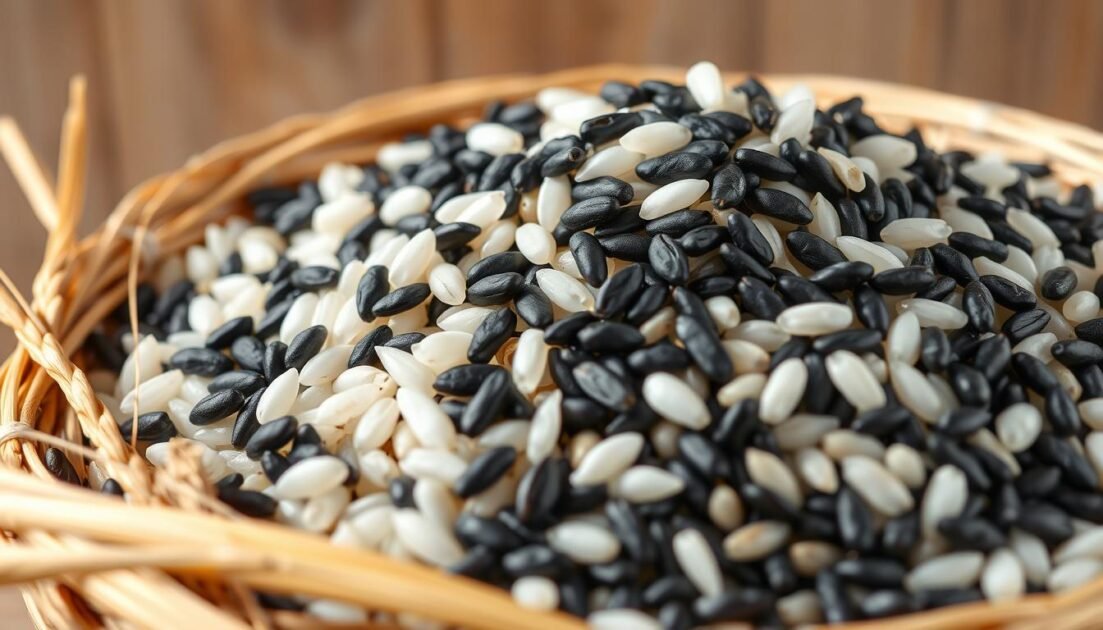Kalanamak is a Nepal-India rice, scented. Its name translates to the literal meaning – black husk, kala = black and suffix ‘namak’ or salt. Its original cultivation took place during the Buddhist period about 600 BC. It was particularly popular among people in Himalayan Tarai of Nepal and also in parts of eastern Uttar Pradesh, also referred to locally as the “black pearl among perfumed”. It featured in Food and Agriculture Organization of the United Nations‘s Speciality rices of the world book.
Acreage under this variety has declined sharply, pushing it towards extinction, for reasons including:
- Panicle blast epidemics in 1998 and 1999
- lodging and tall stature causing lodging in crops
- Long harvest period (6 to 7 months)
- low-quality seeds and research support
Kalanamak was cultivated extensively in Kapilvastu and UP’s Tarai belt, which included districts Siddharth Nagar, Sant Kabir Nagar, Maharajganj, Basti, Gonda, and Gorakhpur. Until the 1990s, the variety accounted for more than 10% of the total rice cultivation area in Siddharthanagar. However, acreage growing this variety in this district declined to <0.5% of total rice cultivation during 2002.

History
Kalanamak rice has been cultivated since the Buddhist period (600 BC). Kalanamak grains were found from the excavation of Kapilvastu. Kapilvastu, part of the Kingdom of King Śuddhodana, father of Gautama Buddha is located in Terai, Nepal. During the excavation of Aligarhwa carbonized rice grains resembling Kalanamak were recovered.
Chinese monk Fa-hain has written that when Buddha first visited Kapilvastu after attaining ‘enlightenment’, he was stopped at Mathla village by the people. The villagers asked Siddhartha to give them prasad. Siddhartha took the rice he had taken in alms and gave it to the people, asking them to sow it in a marshy place. The rice thus produced “will have a typical aroma which will always remind people of me,” he said. Bajha jungle later vanished replaced by Bajha village near Kapilvastu. Mudila village replaced Mathla. The belt is still believed to run between Bajha and Aligarhwa. This variety, if sown elsewhere, loses its aroma and quality.
The first attempt to preserve Kalanamak rice was made by Englishmen William Pepe, diviam aahar, and Edcan Walker (Jamindars of Alidapur, Birdpur, and Mohana) during the British Raj. They constructed reservoirs at Bajha, Marthi, Moti, and Majhauli to produce Kalanamak. They produced this variety for their consumption and transported it to England from Uska-bazar mandi, passing through Dhaka (now in Bangladesh). Due to increasing demand, the British captured the land around Kapilvastu and established Birdpur and Alidapur states. They produced Kalanamak through bonded labor and exported it to Britain. When Gujarati businessmen came to know about this business potential, they formed a mandi at Uska-bazar to export Kalanamak. British “shopkeepers” built a rail route to carry rice via rail to counter them. Uska-bazar mandi became nonfunctional after independence due to negligence, and reservoirs gathered silt. Due to this, production of Kalanamak decreased.
GI Tag
Kalanamak rice was granted the Geographical Indication Tag by the Government of India in 2012. A geographical area was defined where Kalanamak rice can be produced. Kalanamak rice grown only in this area can be labeled as Kalanamak rice. The GI tag is for agricultural, natural and manufactured goods.
The geographical area that covers Kalanamak rice is 26° 42′ North to 27° 75′ North Latitude and 81° 42′ to 83° 88′ East Longitude in UP.
Kalanamak Rice has been approved for 11 districts of Zone-7 of UP. Districts are situated in the divisions of Gorakhpur (Deoria, Gorakhpur, Mahrajganj, Siddharth Nagar districts), Basti (Basti, Sant Kabir Nagar, Siddharth Nagar districts), and Devipatan (Bahraich, Balrampur, Gonda, Shravasti districts).
Quality
Kalanamak rice is a non-basmati rice with medium slender grain length. The four varieties of Kalanamak are KN 3, Bauna Kalanamak 101, Bauna Kalanamak 102, and Kalanamak Kiran were developed by Dr. R. C. Chaudhary. The aroma of Kalanamak rice is said to be Buddha’s gift. It is stronger than all Basmati varieties. It stretches out when cooked, which is one of the most significant quality characteristics.[4] Cooked kalanamak is softer and fluffier compared to other varieties of rice. Amylose content is near about 20% as compared to 24% and above in Basmati. High amylose tends to cause the rice to cook hard and dry. Rice having medium amylose content, between 16% and 22%, generally cooks softer and grains tend to stick together more easily.
Health benefits
Kalanamak rice has a micronutrient content of iron and zinc. It has 11% protein, that’s almost double the amount found in regular rice types. It also has a low Glycemic Index of 49% to 52%, making it relatively sugar-free and suitable for diabetics. The government of India launched its Nutri-Farm scheme in 2013, with the aim of promoting food crops that provide critical micronutrients to enhance the nutrition status of the vulnerable section of society. Kalanamak rice was one of the nutri-crops selected for this scheme.
References
- Rediscovering Scented Rice Cultivar Kalanamak; Reproduced from Asian Agri-History Vol. 9, No. 3, 2005 (211–219)
- ^ “Welcome to Asian Agri-History Foundation (AAHF)”. Archived from the original on 2015-04-03. Retrieved 2015-03-24.
- ^ GOVERNMENT OF INDIA GEOGRAPHICAL INDICATIONS JOURNAL NO. 48 NOVEMBER 29, 2012 / AGRAHAYANA 08, SAKA 1934
- ^ “Amylose and Amylopectine in rice”. vcampus.uom.ac.mu. Archived from the original on 2018-09-03. Retrieved 2017-05-13.
Kalanamak Rice | The legend of kalanamak rice | What is Kalanamak Rice?

 Kalanamak Rice
Kalanamak Rice